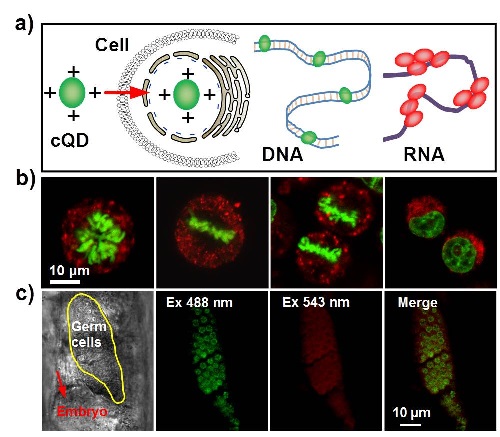
A Chinese research team realized high performance sync-trcking of DNA and RNA in live organisms using technique of cationic carbon quantum dot (or cQD) probe that possessed the capability of both membrane-penetrating and simultaneous tracking of DNA and RNA in live cells and organisms.
This work was done by ZHANG Zhongping and his colleagues with Institute of Intelligent Machines (IIM), Hefei Institutes of Physical Science and was published online in angewandte chemie international edition.
Deoxyribonucleic acid (DNA) and Ribonucleic acid (RNA), that are Nucleic acids, take the most important place as biomolecules for all known forms of life. The dynamics of DNA and RNA structures in live cells are key for understanding cell behaviors. It is of significant interest to cell anatomy and dynamics to directly monitor them in live organisms in real time.
However, it is not easy to directly image these cellular indicators in live cells and organisms for the lack of probe that could distinguish DNA and RNA, and more importantly, cross multiple membrane ranging from cell-organelle to tissue-organ levels.
To tackle the problem, the team explored intensively the carbon materials and chose them as biosensors and bioimaging agents with its low toxicity, easy modification, and excitation-dependent multicolor emission.
And the team increased the cationic charge of cQD probe by a chemical modification method to promote cQD binding with anionic nucleic acids and cell entry.
And they were surprised to see that the cQD emitting spectrally distinguishable fluorescence upon binding with double-stranded DNA and single-stranded RNA, enabling live streaming of DNA and RNA localization and motion in live cell.
More importantly, their experiment results further illustrated that the cationic charge modification enabled cQD to cross many biological barriers ranging from subcellular to tissue and organ levels.
The lab experiment showed that cQD fed to C. elegans did not only enter intestinal wall cells, but also went through interstitial tissues, gonad vesicle and germ cell membrane to germ cell nuclear, thus finally labelling DNA and RNA there.
This work was supported in part by the National Natural Science Foundation of China, the Hefei Physical Science Center Foundation, and the National Basic Research Program of China .

Figure. (a) Schematic drawing of cQD probe interactions with intracellular DNA and RNA. cQD confined by dsDNA emits green fluorescence, and cQD clustered by ssRNA emits red fluorescence. (b) Fluorescent micrographs of dividing cells at different cell cycles. (c) Zoomed-in images of germ cells in the gonad vesicle of wireworm under 488 and 543 nm excitation. (Image by HAN Guangmei)

86-10-68597521 (day)
86-10-68597289 (night)

52 Sanlihe Rd., Xicheng District,
Beijing, China (100864)

